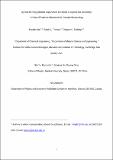Gyroid-Forming Diblock Copolymers Confined in Cylindrical Geometry: A Case of Extreme Makeover for Domain Morphology
Author(s)
Ma, Minglin; Thomas, Edwin L.; Yu, Bin; Li, Baohui; Jin, Qinghua; Ding, Datong; Shi, An-Chang; Rutledge, Gregory C; ... Show more Show less
Downloadmain article (1.816Mb)
OPEN_ACCESS_POLICY
Open Access Policy
Creative Commons Attribution-Noncommercial-Share Alike
Terms of use
Metadata
Show full item recordAbstract
The self-assembly of gyroid-forming diblock copolymers confined in cylindrical geometry is studied using a combination of computer simulations and experiments. The simulations, based on a system qualitatively representative of poly(styrene-b-isoprene), are performed with cylindrical nanopores of different diameter (D) and surface selectivity. The effects of the pore size and surface selectivity on morphology are systematically investigated. Different morphological sequences are predicted for two gyroid-forming diblock copolymers. The experiments are carried out on two gyroid-forming poly(styrene-b-dimethylsiloxane) block copolymer samples confined in the core of continuous core−shell nanofibers of different diameters, which are obtained by a coaxial two-fluid electrospinning technique. The internal microphase-separated morphologies of these fibers are investigated by transmission electron microscopy (TEM). Both simulations and experiments demonstrate that a rich variety of structures spontaneously form for the gyroid-forming diblock copolymers, depending on the conditions of cylindrical confinement. Many of these confinement-induced structures are quite different from those of cylinder-forming or lamella-forming block copolymers. Simulations further show that these structures depend sensitively on the block copolymer composition, surface selectivity, and the ratio D/L0 where L0 is the period of the equilibrium gyroid phase. While the simulation and experimental systems are representative of different chemistries, the morphological predictions of simulations are qualitatively consistent with the experimental observations.
Date issued
2010-02Department
Massachusetts Institute of Technology. Institute for Soldier Nanotechnologies; Massachusetts Institute of Technology. Department of Chemical Engineering; Massachusetts Institute of Technology. Department of Materials Science and Engineering; Koch Institute for Integrative Cancer Research at MITJournal
Macromolecules
Publisher
American Chemical Society
Citation
Ma, Minglin et al. “Gyroid-Forming Diblock Copolymers Confined in Cylindrical Geometry: A Case of Extreme Makeover for Domain Morphology.” Macromolecules 43.6 (2010): 3061-3071.
Version: Author's final manuscript
ISSN
0024-9297
1520-5835